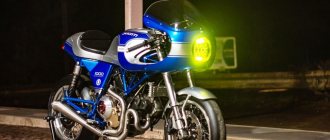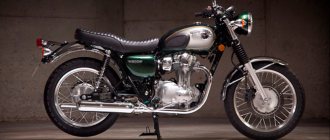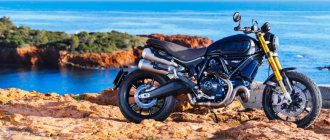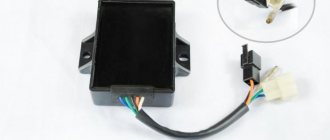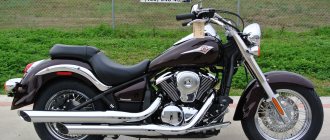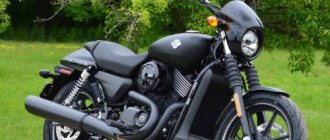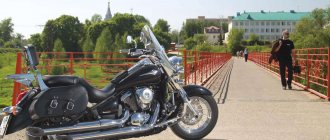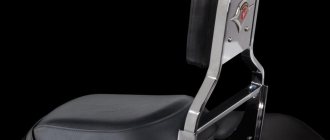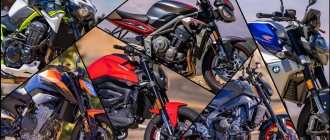Something goes, something comes. Ducati GT1000 Sport Classic and Kawasaki W800
A holy place is never empty, as evidenced by which we can observe an interesting, albeit very sad, reshuffle in the classics sector. Kawasaki is introducing the classic W800 model to the market, and Ducati (you can't help but shed a tear - note from the back rows) quietly, without much fanfare, excludes the GT1000 Sport Classic from the 2011 lineup.
So, first the bad. The outdated 992 cc DesmoDue L-twin, installed in the Ducati GT1000 Sport Classic (and no other model), has long haunted the Italians. These motorcycles were bought quite rarely - only by true retro connoisseurs, and therefore there was little demand for them. But these air vents required plenty of service, causing headaches for dealers and the company itself, as well as for customers who often had to wait for rare spare parts to arrive from the main warehouse.
Another reason for the disqualification of the legendary motorcycle was the presence of a direct competitor in the Ducati model range. We are, of course, talking about the Monster 1100, which is much more in line with the modern ideology of the company, and fits the concepts of “naked” and “classic”.
However, it is too early for Reds fans to grieve, because no one yet knows what exactly, besides the Diavel, they have in store for the EICMA 2010 motorcycle exhibition. Perhaps, with the departure of 992 cc, the Italians will decide to release an updated Sport Classic with the GT1100 index? That is, equipping it with the 1100 cc engine used in the Hypermotard EVO and the same Monster 1100... We'll wait and see. But if you asked ordinary fans like us, we wouldn't mind the presence of a motorcycle icon, reminding us of the rich history of the Italian company. Still, classics are different from classics, and I would never have tried to make up for the disappearance of the GT1000 with the appearance of the light classic W800, if this had not happened almost at once. If the GT1000 is a motorcycle with enormous charisma, full of style and splendor, coming from the pen of the brilliant Pierre Terblanche, then the second is simply a modified copy of the British classics. Yes, the announcement in 1999 of the W650 model, the predecessor of the W800, would not have happened without the appearance at one fine moment of the Triumph Bonneville - it was these motorcycles from the 60s that the Japanese copied, improving the technical part of the British cars.
The Kawasaki W650 was produced for 8 years and managed to win fans both in Japan itself (although the W400 was also in use there), and in Europe, the USA and Canada. However, in 2008 it was discontinued as not meeting modern environmental standards. So, after slowly working on the filling and increasing the volume of the two-cylinder in-line engine, Kawasaki finally decided to announce the W800, timing the official display to coincide with the Cologne motor show Intermot 2010. In short, the Kawasaki W800 is: in-line two-cylinder 773 cc engine, front disc brake, clutch in an oil bath, a 5-speed gearbox, the absence of a kick starter and numerous external details that emphasize the retro style of the device.
To understand “what it’s like,” try to imagine yourself in the 60s (or today, but in the Urals), but without oil puddles under the motorcycle.
text from Motorreview No. 11, 2005:
Alexander Dmitriev,
photo:
Ducati
Ducati Sport 1000:
Ducati Paul Smart LE:
What are the most beautiful sportbikes? What about the managed ones? The correct answer is Ducati. Where is the best place to test Ducati? Of course, in my homeland! There is no broken Russian asphalt that can destroy the thin chassis. There are also no German autobahns, for which 200 km/h is an easy warm-up. But there are many winding mountain roads.
And there is nothing strange that the company from Bologna decided to conduct the first official test of two new sports classics in the vicinity of Florence. And if so, then there is a good reason to visit this beautiful city. After eight hours on the road, it’s difficult to immediately “get into” the process, and therefore the first impression of the motorcycles is ambiguous: the designers were too carried away by the 70s. And who is this powerful old man speaking with a serious British accent? Yes, this is Paul Smart himself, who won the fateful race for Ducati in 1972, which became the leitmotif for the development of two models in 2005... “The dream has become a reality,” Paul simply glowed with happiness, “and these are not the same motorcycles at all,” he said without a shadow of regret... Yes, “that” Ducati, standing in the hotel lobby, really looks like a piece of history.
I don’t know, maybe motorcycle culture in Europe has already reached the point where you want to return to your roots, but I’m afraid that in our Russian reality, few people will appreciate these historical delights. However, what did we build in our time from Dnepr and Urals (well, besides choppers, of course)? There was also a sports style in homemade products from 15 years ago. At least the Sport 1000 reminded me of that weak trend.
To be honest, it was the Sport 1000 that I liked in appearance – just look at its mirrors. Have any manufacturers installed these in the last 30 years? However, the pendulum made of thick round pipes brought a slight melancholy - it is unlikely to be rigid. What about the tires? Despite the promising name Phantom, their design was reminiscent of last year's visit to the motorcycle museum of Giancarlo Morbidelli. Standard questions at a press conference - standard answers: “No, these are not rarities, these are modern sports motorcycles. Not racing, of course, but sports - tomorrow you’ll see everything for yourself.” The representative of Pirelli had a hard time - it was this company that implemented the requirements of Ducati designers to create new modern tires with tubes (no spoke wheels here!). How did you do it? What is the design? What does Phantom have in common with Diablo... And the same answers: the tires are sports, not racing, you’ll feel everything yourself. Tomorrow".
In the morning - good luck! I started the test in a group riding a Sport 1000. We drove out of the gate - and there was not a second to get used to it - a narrow city street curves downhill, and we rush down the oncoming road, overtaking a dead traffic jam at a speed of 70 km/h. Here the hackneyed phrase will be true: “I sat down not “on a motorcycle”, but “into a motorcycle” - the Ducati is so comfortable from the very first meters. You don’t notice the extreme landing with a strong forward lean and the footpegs set back, nor the fact that you are riding the Sport 1000 for the first time. And what convenient mirrors! They only show the picture from behind - you won’t see yourself.
Florence is a small city. Literally 10 minutes later the serpentine road began, ending only in the evening at the hotel. The morning turned out to be cool, and for the first 20 kilometers we got used to the technology. But as soon as the dew cleared, the usual road mayhem began, called the “Ducati factory test”, interrupted only by periodic photo sessions and in populated areas equipped with traffic cameras... A hard pace set by the group leader piloting a Multistrada (it seems that this is really the best and not only Ducati), as always, was somewhat frightening at first - you know, it’s scary to tumble into a turn closed by a rock at a hundred, but it contributed to quick adaptation behind the wheel. And a careful analysis of the motorcycle.
So: this is truly a modern sportbike without a fairing, perhaps, by the standards of some individuals, not powerful enough. In corners it is completely neutral: and the pendulum surprisingly does not spoil life. Well, maybe if just a little - and even then within the framework of still a small favor for comfort instead of hard “racing”. The response to the “gas”, the operation of the gearbox - everything is harmonious, clear and does not give rise to the slightest reason for making complaints. The 1000 DS engine takes the load perfectly, runs smoothly and is quite quiet, which is not typical for Italian motorcycles. The tachometer, pathetically devoid of a red zone, showed 6000–7000 rpm in those moments when I switched to the next higher gear. There is no point in turning the engine any more: like any V-shaped (or L-shaped) “twin”, it works perfectly “on the moment” - its maximum capabilities are quite modest.
Whether it was the lack of autobahns in the vicinity of Florence, or Italy’s strict speed standards forced the organizers to abandon high-speed sections, it is unknown, but I was never able to accelerate the motorcycle faster than 180 km/h. However, I note that at this speed the device is quite stable. In general, everything related to the presented motorcycles can be characterized by the term stability. Despite the imperfect surface of Italian roads with bumps encountered here and there when exiting corners, there were no problems with steering wheel wobbles at all. They know how to design the chassis for Ducati! Neither less nor more – it’s very rare not to want a steering damper installed on a sports motorcycle.
Unfortunately, there was a fly in the ointment, which, as expected, was the new “designer” tires. Either the design played a role, or the rubber composition or design, but the fact is that their quality is low. No, no question, for a quiet touring ride they are very good, but at the exits of fast turns the rear every now and then wants to slide off. However, here everything is quite predictable and smooth - you won’t fall right away, but these tires really limit the capabilities of fast motorcycles. So much so that we can recommend installing better tires. By the way, you shouldn’t be afraid of the cameras inside.
Sportiness also has another side: after two hours of dynamic movement, my arms were tired from excessive stress on them. Another hour later, my left hand began to cramp from the clutch. Then my hand started to get numb, so much so that before the lunch break I stopped using the clutch altogether. Having rested and slightly refreshed, I went to learn Paul Smart, and in splendid isolation: my foreign colleagues (alas, there were no one else from Russia) were all tired of motorcycles, which, for the above reasons, is not at all surprising. A colleague from Estonia, for example, switched turns with his right hand at the end of the test. In such an event, riding alone has both pros and cons: it’s more comfortable to ride alone, but it’s psychologically harder; you won’t be able to move very quickly. As a result, I drove the first hundred kilometers along the well-known morning route.
There was no limit to my surprise when I didn’t realize at all that the motorcycle was equipped with Ohlins - from the steering damper to the rear monoshock. Well, it's not very appropriate here. Maybe if the track was a little faster, the corners were a little deeper, and the road a little worse, I would have felt all the differences of exclusivity (the presence of expensive suspensions is usually noticeable). But it’s worth mentioning separately the brakes, which are the same on both versions. Migrated from the company's sportbikes, they work superbly: the front one is perhaps even too harsh, the rear one, on the contrary, is extremely softened, so much so that you can only lock a wheel on purpose.
However, in some places the form dominates the content: for example, the fairing is inconvenient - it pinches the fingers lying on the levers when the steering wheel is in extreme positions. It was not possible to test its effectiveness - 180 km/h, alas, remained the test limit. Unfortunately. The tank also turned out to be inconvenient - contrary to the traditions of the company, it does not contribute to the feeling of a narrow motorcycle and is uncomfortable for the knees. Well, we don’t have to talk about the fact that you can’t really see anything in the mirrors.
What's the result? Two excellent sports motorcycles designed for short and infrequent dynamic rides. Alas, the “budget” modification of the Sport 1000 seemed much more interesting to me than the Limited Edition. I concluded for myself that such a motorcycle should not be the first or even the second in the garage. But if you are a true connoisseur of motorcycles, pay attention to these beauties. Even if you don't like them at first sight.
options
| Ducati Sport 1000 | Ducati Paul Smart LE | |
| Year of debut/year of release | 2003/2005 | 2003/2005 |
| Dry weight | 179 kg | 181 kg |
| Curb weight | 208 kg | 210 kg |
| Length Width Height | 2180/1030/930 mm | 2180/1150/870 mm |
| Base | 1425 mm | 1425 mm |
| Seat height | 825 mm | 825 mm |
| Ground clearance | 160 mm | 160 mm |
| Gas tank volume | 15 l | 15 l |
| Front fork angle | 24° | 24° |
| Engine | 992 cm3, 4-stroke, 2-cylinder, L-shaped, desmodromic, 4 valves, air cooled | 992 cm3, 4-stroke, 2-cylinder, L-shaped, desmodromic, 4 valves, air cooled |
| Bore/Stroke | 94/71.5 mm | 94/71.5 mm |
| Supply system | fuel injection | fuel injection |
| Compression ratio | 10 | 10 |
| Power | 92 hp at 8000 rpm | 92 hp at 8000 rpm |
| Torque | 91 Nm at 6000 rpm | 91 Nm at 6000 rpm |
| Transmission | 6-speed gearbox, multi-plate dry clutch, chain | 6-speed gearbox, multi-plate dry clutch, chain |
| Frame | spatial, steel | spatial, steel |
| Front suspension | inverted fork Ø43 mm, travel – 120 mm | inverted fork Ø43 mm, travel – 120 mm, adjustments – rebound, compression, preload |
| Rear suspension | monoshock absorber, stroke – 130 mm, adjustments – compression, rebound, preload | monoshock absorber, stroke – 130 mm, adjustments – compression, rebound, preload |
| Front brake | 2 discs Ø320 mm, 2-piston calipers | 2 discs Ø320 mm, 2-piston calipers |
| Rear brake | disc Ø245 mm, 1-piston caliper | disc Ø245 mm, 1-piston caliper |
| Front wheel | 120/70–17 | 120/70–17 |
| Rear wheel | 180/55–17 | 180/55–17 |
| Maximum speed | more than 200 km/h | more than 200 km/h |
| Acceleration 0–100 km/h | 3.5 s | 3.5 s |
| Fuel consumption | 7.4 l/100 km | 7.4 l/100 km |
BMW Motorrad laser headlights
In the case of the K 1600 GTL, the concept vehicle shown here, it is worth noting that the BMW Motorrad laser headlights are a derivative of the BMW Group's automotive division. The innovative laser technology is already available on the new BMW 7 Series as well as the BMW i8. Since this technology was created with an eye to the future, BMW Motorrad has now adapted it for use in the motorcycle industry. The laser headlight not only produces extremely bright, pure white light, but it also has a lighting range of 600m, which is twice the lighting range of traditional headlights . Night driving safety has now been significantly improved as a result of not only increased range, but also the accuracy and quality of road lighting. Moreover, this laser technology will have a very long service life due to its compact, robust and maintenance-free design.
BMW Motorrad installed a laser headlight on the K 1600 GTL concept model as a test of its feasibility. BMW Motorrad is testing the use of this technology on production vehicles during its preliminary development.
At the moment, the technology is still too expensive to be used in production motorcycles. However, due to the large-scale use of technology in the automobile industry, the price structure is expected to take a downward trend. Thus, its use in motorcycles can be envisaged in the medium term.
BMW Travel Gear – REVIEW
GELÄNDE
/STRASSE
text and photo: Anton Vlasov
>>BMW annually expands its range of branded equipment, adding completely new models to the catalog and refreshing well-known old ones. However, the most recognizable and popular protective clothing from the Bavarian manufacturer was, is and, I am sure, will be the equipment of the GS enduro series, which in terms of cult status can compete with the touring motorcycles of the same name from the German brand!
BMW GS helmet RUB 37,850
A universal helmet that can be used both for driving around the city and for off-road excursions. Actually, in this respect the concept of the BMW GS completely coincides with the idea of the all-terrain vehicles of the same name. There are three helmet configurations available:
1) with visor and visor
2) without a visor, but with a visor
3) with a visor and without a visor.
In the first version, this is a typical enduro helmet for use in a mixed, so to speak, driving cycle, the second incarnation is for high-speed driving on asphalt, when the best aerodynamics are required, and the third version is designed for the use of a cross-country mask instead of a visor, and therefore is the most off-road. The helmet shell is made of a composite material consisting of a base multilayer plastic and carbon fiber reinforcement. Inside there is a segmented polystyrene foam insert with good shock-absorbing properties, plus a completely removable lining (side “cheeks” and central part). The BMW GS model does not have a simple visor, but with a double glass (in fact, it is a traditional visor, but with a pre-installed Pinlock - removable, of course). The external visor is scratch-resistant, and the internal “screen” does not fog up.
BMW communication RUB 22,980.
Unlike its predecessor, the 2015 BMW GS is prepared for the installation of a proprietary communication system, and therefore it surprisingly harmoniously fits into the exterior of the helmet and is organically integrated into the “interior”. However, it is unfair to impersonally write “installed”, since the issue of installing the hardware was handled by a familiar BMW motorcycle owner who already had experience in carrying out this difficult operation. If I had taken on this matter myself, I’m not sure that the mission would have been completed... Therefore, if you order a BMW communication system, soberly assess your strengths and abilities in fine mechanics, radio physics and a little in nuclear energy.
BMW has a very advanced communication system, created using first-class components. For example, the central board is produced by the German company Peiker Acustic, specializing in the production of professional audio equipment. There is a suspicion that other parts of the BMW headset, including stereo speakers and a microphone, are also from Peiker... The 1900 mAh nickel-metal hydride battery belongs to FDK Corporation, a Japanese company founded half a century ago. By the way, the communication system has very decent battery life: the manufacturer claims 10–12 hours of operation on a single battery charge!
The functionality is also pleasing: communicating with a passenger in intercom mode, listening to music from a player or motorcycle music system, receiving instructions from a GPS navigator, talking on a mobile phone... At the same time, the BMW headset has a very wide operating temperature range: from –20 to +50° C! The weight of the device is about 150 g.
With the perfectionism characteristic of the Germans, BMW engineers also took care of the good noise insulation of the GS model (which is rare for enduro helmets): in addition to precise assembly and the highest quality of workmanship, a removable deflector in the chin part of the helmet also contributes to the acoustic comfort of the rider. Of course, there is a dust filter that can be easily removed and washed with water. According to BMW, the GS helmet spent a lot of time in the wind tunnel, where specialists worked on its streamlining, as well as on increasing the efficiency of the ventilation system. With a visor and visor, the model weighs about 1450 g, which is very good for a helmet of this class!
BMW Rallye 3 gloves RUB 5,090
Rallye 3 are lightweight gloves without lining, which by default shifts the balance of their qualities towards off-road driving. However, these are not cross-country “rags”, which have less protection than rubber surgical gloves, but a well-equipped, but at the same time lightweight option. I would even say that in terms of protection, the Rallye 3 model almost reaches the standard of short city gloves! The knuckles are covered with a hard pad, which is “finished” on the inside with a special foam material that absorbs impact energy.
The lower part of each glove is “decorated” with kangaroo leather, and SuperFabric protective material is used in particularly problematic areas that experience increased stress when the rider falls from the motorcycle. BMW designers also did not forget about ventilation, which is especially important when driving off-road: air channels are provided in the upper protective pads, and a ventilated mesh material is used between the “fingers.”
BMW Gravel motorcycle boots RUB 20,990
Although BMW positions the Gravel specifically as an enduro boot, I would classify these shoes as an intermediate class, which is closer to all-terrain touring than to overcoming severe off-road conditions. Because for real enduro, the Bavarian motorcycle manufacturer’s catalog includes the Rallye GS Pro model, which is much more protected, high-tech and... highly specialized. Gravel motorcycle boots are a reasonable compromise between a decent, but not maximum, level of “armor” and high comfort, which allows these motorcycle boots to be used in a wide variety of travel scenarios.
The main material is soft but rather thick (2.4–2.6 mm) cowhide, impregnated with a hydrophobic material. In addition, a breathable Gore-Tex membrane helps in the fight against water elements. There are, of course, not as many protective inserts and elements here as in the Rallye GS Pro, however, these boots cannot be called soft slippers either: protection of the tibia and ankles, made of special foam, reinforced areas in the toe and heel, thick and a durable rubber sole... There are polyurethane linings so that the left motorcycle boot does not wear off when changing gears of the motorcycle, and the right one... apparently, for symmetry.
Textile suit BMW Rallye 3 Jacket – RUB 44,590. Pants – RUB 35,790
The Rallye 3 textile suit is the hallmark of the BMW branded equipment collection year after year! It is the Rallye 3 enduro suit that more often than other models from the Bavarian company’s catalog flashes on the streets of cities and is often found in the most distant countries - of course, dusty, shabby, but invincible... Even from the first impression, this is a very high-quality and durable suit, the popularity of which is clearly justified . The Rallye 3 jacket and pants are sold separately, but these are items from the category of “two boots in a pair” and, in my opinion, they should be considered as a single system. Both elements of the suit are made of durable high-tech synthetic material Cordura, and both of them are tightly stuffed with first-class NP2 protectors - Rallye 3’s “textile” level of protection is unrivaled! There are even protective inserts on the thighs, which is not often found in enduro pants. Rallye 3 is an all-weather and, I would even say, all-season suit, in which you can ride both in the most merciless heat and at sub-zero air temperatures.
There is a removable membrane called CARE, which has waterproofing properties, is windproof, but still “breathes”. And in case of the already mentioned desert heat of the jacket... you can unfasten the sleeves, transforming it into a vest! The ventilation of the BMW suit is also in perfect order: to find all the numerous channels and flaps, I even needed the help of the user manual! But, as is usually the case, the beauty of quality things is in the attention to detail. For example, on the left sleeve of the jacket there is a small pocket with a transparent top - here you can put a mobile phone, keys or some other small essentials. At the back there is a compartment for a hydration pack with a valve opening for a drinking tube, plus there, on the “back”, there are two large pockets where even several half-liter bottles of water can fit.
On the inside of the legs there are beautiful leather pads with embossed “BMW Motorrad” inscriptions, and on the outside there are reflective stripes (which are also on the jacket). Well, and, of course, the jacket and pants can be zipped together into a single spacesuit.
BMW Group
The BMW Group, with its three brands BMW, MINI and Rolls-Royce, is the world's leading manufacturer of premium cars and motorcycles and also provides high-quality financial and mobility services. The BMW Group is a global concern with 30 production and assembly plants in 14 countries and a global sales network in more than 140 countries.
In 2014, the BMW Group sold approximately 2,118,000 cars and 123,000 motorcycles worldwide. The company's profit before tax for the reporting year 2013 was equal to 7.91 billion €, and income was approximately 76.06 billion €. As of December 31, 2013, the BMW Group had a workforce of 110,351 people.
The success of the BMW Group has always been based on long-term thinking and responsible action. Therefore, the company has created environmental and social sustainability throughout its value chain, takes full responsibility for its products and focuses on resource conservation as an integral part of its strategy.
BMW Motorrad Race Helmet Matt Black, article number 76318548226
The BMW Lifestyle Collection of souvenirs and accessories is one of the largest collections among auto brands and, perhaps, the most emotional and stylish. This is no coincidence, since BMW cars are among the most emotionally rich - in this regard, their owners are especially strongly attached to their cars and cannot even imagine themselves with another car. It's all about the special magic of BMW - every car is imbued with sport and adrenaline.
BMW cars have a transport function as a secondary one, and the primary one is the pleasure of driving a car. This is not to say that owners of other cars do not like them, but they perceive their car to a much greater extent as an item of status or simply a means of transport. Of the relatively “mass” cars, the only exceptions are Alfa Romeo and, probably, Porsche.
That is why every BMW owner will gladly accept any gift related to his favorite car. BMW gifts, as our customers often call them, will make the life of the owner of this car even more colorful and will allow you to remember your iron horse more often. Thus, having a useful BMW souvenir will certainly brighten up the anticipation of the next meeting with your car.
Several gifts with the BMW logo are perfect for the office: a mug, a pen, a notepad, a business card holder. A scale model of BMW - especially a 1:18 scale model - would look great on your desktop. All other items in the BMW collection are perfect for everyday life. Particularly popular are: baseball caps, keychains, wristwatches, sports bags and clothing. Therefore, when making a gift, you will not miss in any case, because... All products are extremely useful, made of very high quality and will please the owner for a long time.
BMW Lifestyle accessories are very popular and fashionable in the West. Interesting fact: initially this collection was created solely for marketing purposes - to promote and advertise their cars. That is, for example, a BMW umbrella is a “walking” advertising banner, and the client also pays for it. A bicycle is an advertising banner on wheels, and the more products with the BMW logo, the better for the automaker. But there is one very important point here: this additional advertising will only work to your advantage when all the products look great and are well made. Ugly and/or low-quality souvenirs and accessories will only do harm - that is why, over time, BMW created entire design studios for souvenir collections and hundreds of people work there! Further, history turned in such a way that this collection became so popular that it no longer required much effort to promote it; moreover, it even brought significant income to the company. Of course, even now advertising and marketing tasks are put at the forefront, but the collection itself has long become a kind of example of style and quality among similar collections.
In Russia, even many BMW owners do not know about the existence of such an extensive and interesting collection, while in Europe and the USA, BMW souvenirs and accessories have been considered excellent gift ideas for more than 10 years. This is true - after all, most of the items in the collection are very useful in life, and if you add cool design, quality and emotionality of the brand, then it’s difficult to find a better idea for a gift. Our BMW online store offers you the widest selection of souvenirs and accessories that you can give as a gift. We guarantee the best prices and real pleasure from your purchase!
Motorcycle helmet with built-in HUD display
A motorcycle helmet with a built-in HUD display—the information you need on the road is always in your sight. In road traffic, in order to get into a dangerous situation, it only takes a split second to distract your attention. In 2003, BMW became the first European automaker to introduce a HUD display as optional equipment for BMW vehicles.
The BMW helmet HUD displays required or desired movement and vehicle information directly in the driver's field of view, allowing the driver to remain constantly aware of the road and avoid distractions. It seems to me that this is an even more important function for motorcycles than for cars, because... In order for a motorcycle driver to get into a critical situation on the road, he only needs to divert his attention for a very short period of time.
Aiming for this technology to be used in future motorcycles and having carried out preliminary development, BMW Motorrad has equipped the helmet with a HUD display function. This feature allows the data image to be displayed directly in the driver's field of vision. This means that the driver no longer has to quickly glance at the dashboard to read the necessary information and can fully concentrate on the road traffic without distractions.
All displayed information can be freely customized, which is ideal for driver safety, since at any time the information that is significant and can help in the current situation will be displayed.
The necessary information will ensure safety, comfort and even a better riding experience. The helmet display provides safety-relevant information including information related to the technical condition of the motorcycle, such as tire pressure, oil level, fuel level, driving speed, selected gear, speed limit, as well as traffic sign recognition, plus warnings about possible dangers.
Helmet with built-in HUD display
With the help of the future V2V (vehicle-to-vehicle) communication function, it will be possible to display information in real time, for example to provide early warning of any sudden possible hazards on the road.
In addition, the helmet's HUD display allows you to visualize the necessary content designed to increase the driver's comfort. For example, a planned route using a navigation device before the journey begins.
Also, a motorcycle helmet with a HUD display offers interesting possibilities for creating a highly emotional motorcycle riding experience, even more intense than ever, while at the same time guaranteeing increased rider safety. For example, an action camera located inside the helmet and facing forward can record video footage of the journey directly from the helmet. And in the future, a second camera installed at the back of the helmet will serve as a “digital rear view mirror.” Last but not least, this technology will allow you to see other drivers in a group of motorcyclists. This will enable the driver, if necessary, to see where his comrades are at any time.
The motorcycle helmet is also equipped with a built-in mini-computer and loudspeakers, and is adjusted using the BMW Motorrad multi-controller located on the left handlebar. In addition to adjusting the camera, this control will also allow the driver to conveniently select the information he needs.
The technology for displaying the necessary information can be integrated into existing helmets and this will not negatively affect the wearing comfort or safety of the driver. The operating time of the system with two replaceable batteries is approximately 5 hours.
BMW Motorrad wants to bring this innovative technology into series production within the next few years and thus add even more safety to its wide range of driving equipment.
